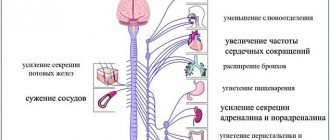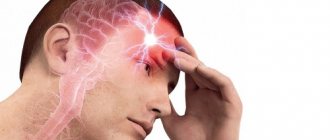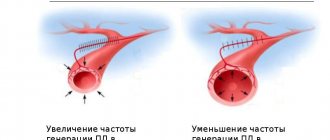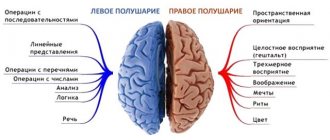Reasons for violation
Pathology manifests itself as a malfunction of the autonomic nervous system. This disease occurs in approximately every third adult, regardless of place of residence and age. Autonomic dysfunction in children occurs in approximately 30%. As a rule, the first symptoms appear in childhood or adolescence.
The disease is characterized by malfunctions of internal organs. Reasons for the development of VSD:
- emotional and physical stress;
- hormone imbalance;
- stressful situations;
- diseases of the endocrine system;
- bad habits;
- infectious diseases;
- lack of vitamins;
- passive lifestyle.
Often, the first manifestations of vegetative-vascular dystonia appear after suffering diseases of the central nervous system (CNS) or mental disorders. The body develops defense mechanisms against diseases of the nervous system, therefore, at the slightest stress or overwork, these mechanisms are activated and symptoms of dystonia appear. This response of the immune system is developed after neurological and mental disorders, as well as infectious and viral diseases.
The impetus for a disorder of autonomic function can be poor nutrition, lack of regular physical activity, obesity and a sedentary lifestyle.
Autonomic dysfunction develops with hormonal imbalances, during pregnancy and at the onset of menopause. Pathology may appear against the background of diseases of the cervical spine or diabetes mellitus.
The development of the syndrome is also influenced by genetic predisposition. Bad habits, such as smoking and alcohol abuse, also provoke disorders of the autonomic nervous system.
Vegetovascular dystonia is a syndrome that describes autonomic disorders. There are several types of VSD. Dystonia is distinguished:
- hypotonic type;
- hypertensive type;
- cardiac type;
- mixed type.
Each type of disease has characteristic symptoms.
Vegetative-vascular dystonia
Doctors in the post-Soviet space often diagnose such a phenomenon as vegetative-vascular dystonia. In fact, it is not a disease, but a collection of certain symptoms. In ICD-10, vegetative-vascular dystonia does not exist as a separate disorder, but it can be classified as code F 45.
3 - “somatoform autonomic dysfunction of the nervous system.” Also, in accordance with the complex of pathologies of the nervous system, it corresponds to the international classifiers G90-G99 - “disorders of the autonomic nervous system.”
In Soviet times, vegetative-vascular dystonia in adolescents was found in 80% of cases of malaise - today these figures are not much lower.
Vegetative-vascular dystonia in women is observed 3 times more often than in men - on average, about 60% of the female population from 20 to 40 years old “suffers” from this disease. In Europe and the USA such a diagnosis does not exist.
Vegetative-vascular dystonia in simple words means a disorder of the autonomic nervous system. The vegetative department is responsible for the following functions of the body:
- balance of temperature indicators;
- heart rate;
- blood pressure level;
- metabolic rate;
- sweating, which ensures the removal of harmful toxins and excess fluids from the body;
- general adaptability of the body to the conditions of the outside world.
The diagnosis in question in domestic medicine means numerous disorders of a person’s somatic (physical) health.
articles
- Signs of vegetative-vascular dystonia
Signs of vegetative-vascular dystonia
Vegetative-vascular dystonia in adults and adolescents is manifested by the following fundamental symptoms:
- causeless constant feeling of exhaustion, general weakness and fatigue;
- attacks of fear and panic;
- shortness of breath, attacks of suffocation;
- migraine symptoms;
- pain in the chest;
- changes in health depending on weather conditions;
- dizziness, tinnitus;
- mood swings;
- stomach ache;
- chills, a feeling of coldness in the hands and feet;
- rapid heartbeat, attacks of tachycardia;
- deterioration of memory and thought processes;
- a number of other symptoms.
Failure in the activity of the autonomic system affects the functioning of blood circulation, heat exchange and the gastrointestinal tract.
Patients may experience fainting. The vague term VSD can hide many pathologies: from unexplained somatic diseases, depression and psychosis to central nervous system disorders.
Types
Vegetative-vascular dystonia, the symptoms of which are similar to the manifestations of individual diagnoses (neuroses, organic lesions of the central nervous system, hormonal disorders, etc.), cannot act as a separate disease. But in Russian medicine it is customary to distinguish types of vegetative-vascular dystonia.
- The hypotonic type is a disorder of the autonomic department in combination with damage to the blood flow of internal organs. It manifests itself as low blood pressure, pain in the heart area, dizziness, and surges in blood pressure. This type of vegetative-vascular dystonia occurs more often in children than in adults.
- According to the hypertensive type, the pressure, on the contrary, is higher than normal limits. Possible nausea and nervous irritability.
- The cardiac type includes bradycardia - slow heartbeats. It manifests itself as pale skin, attacks of fever or chills, sudden colic and pain in various parts of the body. Chest discomfort and tachycardia also accompany the cardiac type.
- Cerebral type – a disorder of cerebral vascular tone. Vascular spasms occur and, as a result, insufficient blood flow to the brain. Among the symptoms of the cerebral type are observed: loss of vision, dizziness and pain in the head, pain in the heart, fever and other standard vegetative-vascular signs.
- The vagotonic type of vegetative-vascular dystonia includes symptoms of cardiovascular pathologies, hormonal disorders, diseases of the respiratory and gastrointestinal systems. There may be signs of mental disorders. Moreover, tests and studies do not reveal somatic or bodily disorders.
- Mixed type - a combination of symptoms from all previous types.
Pathogenesis
Classification of VSD by causes:
- infectious or toxic - its causes are the ingestion of poisons, bacteria and viruses into the body;
- genetic - the causes of occurrence are considered to be hereditary predisposition;
- psychosomatic - the reasons are hidden in psychotraumatic situations and prolonged stress;
- endocrine - due to hormonal disorders, etc.
The appearance of symptoms of vegetative-vascular dystonia is provoked by factors such as poor lifestyle, sleep disorders, excessive physical and mental stress, hormonal imbalances, mental problems and a number of other diseases.
Symptoms of vegetative-vascular dystonia in women more often occur during pregnancy, breastfeeding and menopause. Vegetative-vascular dystonia in men appears much less frequently if there are no causes of hormonal disorders.
Vegetative-vascular dystonia in adolescent children is a common occurrence due to puberty, a difficult period of restructuring of the body. For teenagers, such a diagnosis can be considered almost the norm.
At a younger age, up to 10-11 years, VSD is rarely observed and is almost asymptomatic.
Treatment
Doctors from many countries argue about how to treat vegetative-vascular dystonia.
In Russia and the countries of the former USSR, it is customary to prescribe drug treatment - antipsychotics, sedatives and cardiac drugs. Psychotherapy or lifestyle adjustments are practically not practiced.
Foreign medicine pays special attention to analyzing the patient’s daily routine and nutrition. An adequate sleep schedule, a proper diet with healthy foods and vitamins, and moderate physical activity are important.
VSD of the hypotonic type is treated with manual therapy - massage courses prescribed by the doctor. Physical therapy, prescribed by a rehabilitation doctor, also has a beneficial effect. Exercises include moderate swimming, slow running, proper breathing techniques, and race walking.
A proper diet helps alleviate the patient’s condition and acts as a preventive measure not only for VSD, but also for many other diseases.
Source: https://depressia911.ru/depressiya/vegeto-sosudistaya-distoniya.html
VSD hypotonic type
VSD of the hypotonic type manifests itself at an early age, and predominantly women suffer from the disease. The disorder develops against the background of low blood pressure (100 mmHg and below). Symptoms of the disorder are nonspecific and manifest themselves individually in each patient. The following symptoms are common:
- limb spasms;
- heart rhythm disturbance;
- breathing problems;
- headache;
- fainting;
- Digestive problems.
Patients complain of cramps of the lower extremities, especially at night. Hands and feet feel cold even in hot weather. Heart rhythm disturbances may occur, especially after minor physical activity. Breathing problems are expressed by difficulty taking a deep breath. Breathing is usually shallow and rapid. Patients often complain of headaches and dizziness.
Digestive problems are expressed by diarrhea, frequent heartburn, and impaired bowel movements.
Some patients report neuropsychiatric disorders - panic attacks, attacks of fear, sudden irritability or depression. VSD is often accompanied by sleep disturbances, constant fatigue and apathy.
This form of vegetative-vascular dystonia does not have a code according to ICD 10 due to the general nature of the symptoms. This also causes problems with diagnosing the disorder.
VSD codes in ICD 10
In ICD-10, the VSD disease code is set depending on the predominant symptoms. Dystonia does not have its own code designation, so patients may have a different code in their outpatient records.
The diagnosis of “vegetative-vascular dystonia” is made only in our country - ICD-10 does not distinguish VSD as a separate disease. Therefore, the alphanumeric designation of the disease is selected based on the prevailing symptoms of VSD and disorders identified during diagnosis.
Vegetative-vascular dystonia is designated by a code in the range G00-G99. These numbers indicate pathologies of the nervous system. For example, a disease can be encrypted:
- G99.0* - autonomic neuropathy with endocrine and metabolic disorders;
- G99.1* - includes other disorders of the autonomic nervous system occurring against the background of concomitant diseases;
- G99.8* - denotes specified disorders of the nervous system in diseases classified in other headings.
VSD according to ICD-10 may have the code R45, which indicates symptoms related to the emotional sphere of a person.
- Diagnosis is often coded under R45.8, which stands for Other Symptoms and Signs Relating to Emotional State.
- Code F45.3 is used primarily by neuropsychiatrists. Alphanumeric coding determines changes in well-being in adult patients with a symptom complex of disorders characteristic of somatoform dysfunction of the ANS.
When assigning a disease code, the type of VSD is also taken into account - hypertensive, hypotensive or mixed nature of the syndrome.
Codes for hypertensive form of dystonia
The hypertensive variant of VSD is characterized by a periodic increase in blood pressure. Hypertension manifests itself:
- discomfort;
- severe headaches;
- nausea;
- loss of strength.
The code is selected based on the development of hypertension:
- Code I10 indicates primary hypertension. The patient has not been diagnosed with organic pathologies that can cause pressure surges.
- Code I15 is used if hypertension in VSD is secondary and develops against the background of some pathology.
The main ICD-10 code may be supplemented by others depending on concomitant VSD diseases.
Codes for hypotensive form of dystonia
Hypotension in dystonia manifests itself:
- loss of strength;
- increased drowsiness;
- yawning;
- tachycardia;
- internal trembling.
During an acute attack of arterial hypotension, the following symptoms appear:
- darkening before the eyes;
- unsteadiness and uncertainty of gait;
- severe dizziness;
- fainting (in severe cases).
The hypotonic type of VSD is most often referred to as code F45.3, which denotes somatoform dysfunction of the autonomic nervous system. The disease is also encrypted with codes:
- I95.0 - idiopathic hypotension;
- I95.1 – orthostatic hypotension that occurs when standing up;
- I95.8 – other types of hypotension;
- I95.9 – hypotension of unspecified etiology.
To select the correct section in the international classification of diseases, the doctor carefully collects anamnesis, determines the mechanism of development of the disease and determines the influence of organic pathologies.
Neurocirculatory dystonia (NCD) is encrypted in the international classification of diseases with code F45.3. This designates somatoform dysfunctions that occur with episodes of heart rhythm disturbances and blood pressure instability.
How codes are set for children with VSD
Identification of disease codes according to the ICD in children is no different from encoding diagnoses in adult patients. The development of dystonia in a child may be associated with:
- somatic;
- infectious diseases.
In this case, VSD is a secondary pathology, so the alphanumeric designation of the primary disease is indicated first. Dystonia developing in a child is coded by a pediatric neurologist.
The International Classification of Diseases is a document approved by the World Health Organization. According to generally accepted regulations, certified doctors treating private and public medical institutions are required to use the specified disease encryption standards in their practice.
The use of ICD codes is important not only for studying the characteristics of pathologies and determining the frequency of their detection. Thanks to universal disease coding, patients do not have to worry about how they will communicate their diagnosis to doctors who do not speak their language.
Source: https://distonija.ru/tipy-vsd/vsd-kody-po-mkb-10
Hypertensive type of disorder
VSD of the hypertensive type, as the name implies, develops against a background of high blood pressure. As a rule, symptoms of pathology appear when the patient’s blood pressure rises.
This form of the disease is characterized by the following symptoms:
- noise in ears;
- headache;
- visual impairment;
- nervous tension;
- tremor of fingers;
- problems with coordination of movements;
- panic attacks;
- nausea;
- impaired memory and concentration.
Tinnitus is accompanied by visual impairment. Patients complain of the appearance of floaters in the field of vision. All this is associated with increased blood pressure. Patients often complain of nervousness, nervous tension, and sudden anxiety. These symptoms may be accompanied by nausea and vomiting.
Some patients have problems with coordination of movements - a rapid, fussy gait. Possible problems with concentration and sudden memory loss.
This form of disorder leads to disability due to problems with attention and memory.
Due to the lack of clear symptoms, no ICD-10 code has been assigned for this type of VSD. ICD-10 classifies vegetative-vascular dystonia as a general neurological disorder.
Treatment
Treatment for vegetative-vascular dystonia should be complex, long-term, individual, taking into account the characteristics of autonomic disorders and their etiology. Preference is given to non-drug methods. These include normalizing the daily routine, eliminating physical inactivity, dosed physical activity, limiting emotional influences (TV shows, computer games), individual and family psychological correction, as well as regular and balanced nutrition. Therapeutic massage, acupuncture, and water treatments have a positive effect. The features of physiotherapeutic effects depend on the form of autonomic disorders (for example, for vagotonia, electrophoresis with calcium, caffeine, mesatone is prescribed, and for sympathicotonia - with aminophylline, papaverine, magnesium, bromine). If non-drug treatment is insufficiently effective, individually selected drug therapy is prescribed with a limited number of drugs in minimal doses with a gradual increase to effective ones. In the complex therapy of vegetative-vascular dystonia, great importance is attached to the treatment of chronic focal infection, as well as concomitant somatic, endocrine and other pathologies. *Sedatives are widely used (preparations of valerian, motherwort, St. John's wort, hawthorn, etc.), as well as tranquilizers, antidepressants, nootropics (for example, phenibut, carbamazepine, diazepam, amitriptyline, piracetam, pyritinol). *The use of glycine, pantogam, glutamic acid, complex vitamin and microelement preparations often has a beneficial effect. *To improve cerebral and peripheral circulation and restore microcirculation, vinpocetine (for example, Cavinton), cinnarizine, nicotinic acid, pentoxifylline (for example, Trental) are used. *In case of sympathicotonia, it is possible to use ß-blockers [propranolol (for example, anaprilin, obsidan)], in the presence of vagotonic reactions - psychostimulants of plant origin (preparations of eleutherococcus, schisandra, zamanika, etc.). *Children with intracranial hypertension are treated with dehydration therapy [acetazolamide (diacarb) with potassium preparations, glycerol]. In the complex therapy of vegetative-vascular dystonia, great importance is attached to the treatment of chronic focal infection, as well as concomitant somatic, endocrine or other pathologies. With the development of vegetative paroxysms in severe cases, along with the use of non-drug methods and oral drug therapy, parenteral administration of tranquilizers, neuroleptics, beta-blockers, and atropine is necessary, depending on the nature of the crisis. Dispensary observation of children with vegetative-vascular dystonia should be regular (once every 3-6 months or more often depending on the form, severity and type of course of the syndrome), especially in transition seasons (spring, autumn), when it is necessary to repeat the examination and indications to prescribe a set of therapeutic measures.
Mixed type of pathology
Mixed vegetative-vascular dystonia is often a hereditary disease. Pathology may appear against the background of problems of the cardiovascular system and as a result of certain neurological disorders.
VSD of mixed type is characterized by the following symptoms:
- headache and dizziness;
- change in heart rate;
- visual impairment;
- aching pain in the heart area;
- panic attacks;
- nervous tension;
- vegetative crises.
This form of pathology is characterized by a sudden change in blood pressure; it can rise sharply or suddenly fall, which causes the symptoms of the disorder.
The mixed type of autonomic disorder is characterized by crises, which are accompanied by impaired motor skills, sudden chills and tremor of the fingers. Patients report sudden visual disturbances (blurring in the eyes), decreased hearing (noise or ringing in the ears), and problems with speech.
The second name for VSD is neurocirculatory dystonia or NCD. According to ICD-10, neurocirculatory dystonia is classified as a neurological disorder.
Preventive measures
Prevention of VSD of the hypotonic type includes a set of measures aimed at eliminating diseases that provoked the occurrence of dystonia, as well as increasing tone and increasing productivity. The main preventive measures include:
- inclusion in the daily diet of foods rich in potassium and magnesium (legumes, figs, dried apricots, fresh herbs),
- excluding spicy, fried, salty and smoked foods from the menu,
- It is preferable to replace black tea with green tea, coffee and carbonated drinks with dried fruit compotes and berry fruit drinks.
It is worth regularly consuming medicinal plants and herbs for hypotonic VSD, which help normalize the general condition.
These include: hop cones, lemon balm, peony, motherwort, sage, valerian, mint, immortelle, leuzea and zamanika. You can collect them yourself, purchase them from herbalists, or buy them in the form of ready-made pharmaceutical preparations.
In order to get rid of hypotonic type RVNS, you should definitely include physical activity in your daily schedule. The best options would be: swimming, race walking, table tennis and weight training under the guidance of a competent instructor.
It is recommended to saturate your diet with fresh fruits, vegetables and herbs as much as possible and completely give up addictions.
Somatoform dysfunction
One form of dystonia is somatoform dysfunction of the autonomic nervous system. Pathology is characterized by disruption of the functioning of internal organs without a physiological or pathological cause for the disorder.
Somatoform dysfunction manifests itself at an early age in children and adolescents. The disorder affects those organs whose activity is regulated by the autonomic nervous system.
The following symptoms are characteristic of somatoform dysfunction:
- aching pain in the heart area;
- arrhythmia;
- shortness of breath, difficulty breathing;
- dysfunction of the gastrointestinal tract;
- problems with urination;
- joint pain;
- neurological and mental disorders.
Pain in the heart area bothers the patient at rest or during physical activity. Patients often complain of arrhythmia. Possible breathing problems - shortness of breath, rapid shallow breathing, inability to take a deep breath.
From the gastrointestinal tract, indigestion, constipation or diarrhea may occur. Often a child experiences sudden stomach upset during a stressful situation.
Urinary problems mainly affect children. This is manifested by enuresis and frequent urge to urinate when in public.
Joint pain is episodic. They suddenly appear, intensify with load, and just as suddenly disappear.
Patients are prone to hypochondria and the development of depression. Many people note sleep disorders, groundless fears and anxieties, and suddenly increasing irritability and nervousness.
Vegetative-vascular dystonia according to ICD-10
Vegetative-vascular dystonia (VSD) is a common disease that causes disorders of the autonomic nervous system. As a result, internal organs do not work properly, which leads to unpleasant symptoms.
The signs of the disease are so different that vegetative-vascular dystonia was not included as such in ICD 10.
It is regarded as part of a whole complex of pathologies of the nervous system, corresponding to codes G90-G99 according to the international classifier.
The concept of vegetative-vascular dystonia and its symptoms
Modern medicine does not consider vegetative dystonia syndrome to be an independent disease. This is a certain set of symptoms that are part of various somatic and mental pathologies. The basis of VSD is considered to be an imbalance between the parasympathetic and sympathetic autonomic nervous systems. They are responsible for the proper functioning of internal organs.
The sympathetic nervous system supports the body during various stressful situations. It promotes the release of such important hormones for the body as dopamine, adrenaline, norepinephrine.
Due to this, the dilation of blood vessels in the brain occurs simultaneously with their narrowing in other organs, the heartbeat and ventilation of the lungs increase, blood pressure increases, and the pupils dilate.
As a result, the body is able to endure various stressful and even life-threatening situations.
The parasympathetic system promotes the production of acetylcholine and has completely opposite effects. It is responsible for the dilation of blood vessels in the periphery, reduces the heart rate and their strength, helps reduce ventilation of the lungs, and constricts the pupils.
Normally, these two systems work harmoniously, however, if their actions are not coordinated, various unpleasant symptoms may appear.
When the effects of the sympathetic system predominate, arrhythmias, pressure surges develop, the pulse increases, and the person is tormented by a feeling of anxiety and fear.
Increased action of the parasympathetic system leads to a drop in blood pressure, difficulty breathing, and a decrease in heart rate to 40-50 beats per minute.
Many patients do not take the signs of vegetative-vascular dystonia seriously, however, the symptoms of this pathology can cause serious disorders that affect several organs at once.
Reasons for the development of VSD
Both adults and children are susceptible to the disease. To date, many reasons have been identified that can provoke the development of vegetative-vascular dystonia. The most common of them are worth considering in more detail.
- The cause of the development of pathology may be a person’s genetic disposition. The risk of developing symptoms of the disease in this case becomes twice as high. The development of VSD can be suspected at an early age. It is expressed by instability of the emotional and mental state, rapid exhaustion of the nervous system.
- Prolonged stress, depressive states, severe emotional shock, psychological trauma - all this can negatively affect a person’s condition and cause unpredictable harm to the body. Usually the body copes with short-term mental overloads on its own and quickly enough. But if stressful situations are prolonged, then this is a clear prerequisite for the development of pathology.
- One of the causes of VSD can be excessive physical activity and an overly active lifestyle. Quite often the disease is diagnosed in people involved in sports at a professional level. The daily work of the body for wear and tear, the desire to achieve maximum results in the shortest possible time will eventually lead to the development of pathology.
- A sedentary lifestyle or too little physical activity can also cause the development of dystonia. With such a slow pace of life, the nervous system also malfunctions, which ultimately leads to pathology.
- Vegetative-vascular dystonia, which develops against the background of other chronic diseases, is also common. The root cause can be: diabetes mellitus, osteochondrosis, asthma, problems with the endocrine system.
- VSD can develop with frequent changes in time zones and climate. Each body reacts differently to such drastic changes and not everyone tolerates them well.
- Focal infections and hormonal changes occurring in the body can also contribute to the development of autonomic disorder.
VSD in childhood
The disease in children develops to a greater extent due to excessive emotional stress. Stressful situations, a feeling of constant anxiety, mental stress at school - all this contributes to the appearance of the first symptoms. Also, the cause of VSD can be age-related hormonal changes in the body.
You can determine whether a child is sick by sudden changes in mood, sleep disturbances, decreased activity, and also by rapid fatigue. Also, vegetative-vascular dysfunction may be accompanied by shortness of breath, vomiting, hearing and vision impairment.
Children who lead an inactive lifestyle and are constantly at the computer are more at risk of developing the disease. To avoid the occurrence of vegetative-vascular dystonia, you need to move a lot, play sports, eat right, and also follow a sleep and rest schedule.
Important: A child in a family must live in love and harmony; psychological trauma in childhood can lead to serious complications in the future.
Types of vegetative-vascular dystonia
Since the disease is accompanied by many different and even opposing symptoms, several types of pathology are distinguished. As already mentioned, vegetative-vascular dystonia does not have a code according to ICD 10, but based on the identified disorders, other diagnoses can be made.
Hypertensive type
VSD of the hypertensive type is accompanied by surges in blood pressure, increased fatigue, and general weakness. Severe headaches and frequent mood swings occur. This type of VSD according to ICD 10 corresponds to codes I10, I15 - the first or second stage of arterial hypertension.
Hypotonic type
This type of dystonia, on the contrary, is characterized by a decrease in pressure, therefore, according to the classification, it belongs to psychosomatic pathologies. Manifested by the following symptoms:
- pale skin,
- headache,
- dizziness,
- lowering blood pressure,
- tachycardia or bradycardia.
According to the international classification, the totality of such signs establishes the diagnosis of somatophoric dysfunction (F45.3).
Mixed type
The development of pathology is characterized by changes in vascular tone. Blood pressure readings may deviate sharply up or down. Weakness, apathy, headaches and heart pain develop. Each case must be examined individually by doctors to identify the real cause of the pathology.
Cardiac type
With VSD of this type, pain in the heart develops due to a sharp narrowing of the lumen of blood vessels. External signs of pathology: pale skin, less developed chest. When exposed to unfavorable factors (stressful situations), a person’s condition is aggravated by a feeling of constant fatigue and apathy.
Vagotonic type
Autonomic dysfunction of this type is always accompanied by various disturbances in the functioning of the respiratory system. It is difficult for patients to take a full breath, which causes signs of oxygen starvation to develop and a decrease in blood pressure.
Diagnosis of vegetative-vascular dystonia
When a patient seeks medical help with complaints about the symptoms listed above, the doctor’s main task is to exclude somatic diseases that could provoke the unpleasant condition. For this purpose, a full examination is prescribed, including:
- visual and neurological examination,
- urine and blood tests,
- electrocardiogram,
- blood pressure monitoring,
- Ultrasound of blood vessels and heart,
- electroencephalography,
- computed tomography or MRI.
In addition, you will definitely need to consult a neuropsychiatrist to exclude the development of mental disorders. Only after a complete examination will the doctor be able to establish an accurate diagnosis and prescribe appropriate treatment.
Important: In case of vegetative-vascular dysfunction, it is necessary to regularly monitor blood pressure in order to avoid more serious complications, for example, a hypertensive crisis.
VSD therapy
There is no specific drug course of treatment for vegetative-vascular syndrome. Medicines are selected individually in accordance with the developed symptoms. Doctors will help identify internal problems that provoke an inadequate response of the body to external stimuli.
In addition, the patient will be asked to master any relaxation techniques: yoga, breathing exercises.
It is also necessary to follow other medical recommendations, you will need:
- Properly distribute the time spent on work and rest, and avoid daily mental overload.
- Avoid drinking alcohol completely, as it can give an imaginary feeling of relief, but in reality only contributes to worsening the problem.
- Stop smoking tobacco.
- Carry out hardening procedures every day or at least take a contrast shower.
- Eliminate fatty, fried and canned foods from your diet, as they contribute to the deterioration of blood vessels.
- Include physical therapy into your daily schedule.
By following these simple rules, getting rid of the symptoms of vegetative-vascular dystonia will not be difficult. In severe cases, your doctor may prescribe medications to help stabilize the condition. These include antidepressants and sedatives.
Source: https://osostavekrovi.com/davlenie/vegeto-sosudistaya-distoniya-po-mkb-10.html
Diagnosis of pathology
Diagnosis of VSD is fraught with difficulties due to the lack of specific symptoms. Signs of vegetative-vascular dystonia are characteristic of many different pathologies of the cardiovascular system, internal organs, as well as some types of mental disorders.
To make a diagnosis, it is important to exclude pathologies of internal organs. For this purpose, examination and consultation with a cardiologist, endocrinologist, neurologist and gastroenterologist are indicated.
The following examinations need to be done:
- general and biochemical blood test;
- checking brain activity and vascular condition;
- MRI of internal organs.
If you suspect VSD, you should consult a therapist. After examining and analyzing the patient’s complaints, the doctor will refer you to the next specialist.
What is ICD?
Vegetative-vascular dystonia (VSD) is a symptom complex of diverse clinical manifestations that affects various organs and systems and develops as a result of deviations in the structure and function of the central and/or peripheral parts of the autonomic nervous system.
Vegetative-vascular dystonia is not an independent nosological form, however, in combination with other pathogenic factors, it can contribute to the development of many diseases and pathological conditions, most often having a psychosomatic component (arterial hypertension, coronary heart disease, bronchial asthma, peptic ulcer, etc.).
Vegetative changes determine the development and course of many childhood diseases. In turn, somatic and any other diseases can aggravate autonomic disorders.











